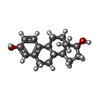[English] 日本語
 Yorodumi
Yorodumi- PDB-1ere: HUMAN ESTROGEN RECEPTOR LIGAND-BINDING DOMAIN IN COMPLEX WITH 17B... -
+ Open data
Open data
- Basic information
Basic information
| Entry | Database: PDB / ID: 1ere | ||||||
|---|---|---|---|---|---|---|---|
| Title | HUMAN ESTROGEN RECEPTOR LIGAND-BINDING DOMAIN IN COMPLEX WITH 17BETA-ESTRADIOL | ||||||
 Components Components | ESTROGEN RECEPTOR | ||||||
 Keywords Keywords |  NUCLEAR RECEPTOR / NUCLEAR RECEPTOR /  TRANSCRIPTION FACTOR / TRANSCRIPTION FACTOR /  STEROID / STEROID /  AGONIST AGONIST | ||||||
| Function / homology |  Function and homology information Function and homology informationregulation of epithelial cell apoptotic process / antral ovarian follicle growth / G protein-coupled estrogen receptor activity / regulation of branching involved in prostate gland morphogenesis / RUNX1 regulates transcription of genes involved in WNT signaling / RUNX1 regulates estrogen receptor mediated transcription /  regulation of toll-like receptor signaling pathway / prostate epithelial cord arborization involved in prostate glandular acinus morphogenesis / nuclear estrogen receptor activity / epithelial cell proliferation involved in mammary gland duct elongation ...regulation of epithelial cell apoptotic process / antral ovarian follicle growth / G protein-coupled estrogen receptor activity / regulation of branching involved in prostate gland morphogenesis / RUNX1 regulates transcription of genes involved in WNT signaling / RUNX1 regulates estrogen receptor mediated transcription / regulation of toll-like receptor signaling pathway / prostate epithelial cord arborization involved in prostate glandular acinus morphogenesis / nuclear estrogen receptor activity / epithelial cell proliferation involved in mammary gland duct elongation ...regulation of epithelial cell apoptotic process / antral ovarian follicle growth / G protein-coupled estrogen receptor activity / regulation of branching involved in prostate gland morphogenesis / RUNX1 regulates transcription of genes involved in WNT signaling / RUNX1 regulates estrogen receptor mediated transcription /  regulation of toll-like receptor signaling pathway / prostate epithelial cord arborization involved in prostate glandular acinus morphogenesis / nuclear estrogen receptor activity / epithelial cell proliferation involved in mammary gland duct elongation / prostate epithelial cord elongation / epithelial cell development / mammary gland branching involved in pregnancy / uterus development / vagina development / TFIIB-class transcription factor binding / androgen metabolic process / steroid hormone mediated signaling pathway / mammary gland alveolus development / intracellular estrogen receptor signaling pathway / cellular response to estrogen stimulus / regulation of toll-like receptor signaling pathway / prostate epithelial cord arborization involved in prostate glandular acinus morphogenesis / nuclear estrogen receptor activity / epithelial cell proliferation involved in mammary gland duct elongation / prostate epithelial cord elongation / epithelial cell development / mammary gland branching involved in pregnancy / uterus development / vagina development / TFIIB-class transcription factor binding / androgen metabolic process / steroid hormone mediated signaling pathway / mammary gland alveolus development / intracellular estrogen receptor signaling pathway / cellular response to estrogen stimulus /  estrogen response element binding / Nuclear signaling by ERBB4 / positive regulation of phospholipase C activity / intracellular steroid hormone receptor signaling pathway / negative regulation of canonical NF-kappaB signal transduction / RNA polymerase II preinitiation complex assembly / protein localization to chromatin / TBP-class protein binding / TFAP2 (AP-2) family regulates transcription of growth factors and their receptors / estrogen response element binding / Nuclear signaling by ERBB4 / positive regulation of phospholipase C activity / intracellular steroid hormone receptor signaling pathway / negative regulation of canonical NF-kappaB signal transduction / RNA polymerase II preinitiation complex assembly / protein localization to chromatin / TBP-class protein binding / TFAP2 (AP-2) family regulates transcription of growth factors and their receptors /  steroid binding / nitric-oxide synthase regulator activity / ESR-mediated signaling / 14-3-3 protein binding / transcription corepressor binding / negative regulation of miRNA transcription / positive regulation of nitric-oxide synthase activity / cellular response to estradiol stimulus / nuclear estrogen receptor binding / steroid binding / nitric-oxide synthase regulator activity / ESR-mediated signaling / 14-3-3 protein binding / transcription corepressor binding / negative regulation of miRNA transcription / positive regulation of nitric-oxide synthase activity / cellular response to estradiol stimulus / nuclear estrogen receptor binding /  transcription coregulator binding / transcription coregulator binding /  stem cell differentiation / stem cell differentiation /  euchromatin / SUMOylation of intracellular receptors / negative regulation of DNA-binding transcription factor activity / euchromatin / SUMOylation of intracellular receptors / negative regulation of DNA-binding transcription factor activity /  transcription coactivator binding / transcription coactivator binding /  beta-catenin binding / Nuclear Receptor transcription pathway / response to estrogen / male gonad development / Regulation of RUNX2 expression and activity / Constitutive Signaling by Aberrant PI3K in Cancer / beta-catenin binding / Nuclear Receptor transcription pathway / response to estrogen / male gonad development / Regulation of RUNX2 expression and activity / Constitutive Signaling by Aberrant PI3K in Cancer /  nuclear receptor activity / positive regulation of nitric oxide biosynthetic process / positive regulation of DNA-binding transcription factor activity / positive regulation of fibroblast proliferation / Ovarian tumor domain proteases / sequence-specific double-stranded DNA binding / response to estradiol / PIP3 activates AKT signaling / phospholipase C-activating G protein-coupled receptor signaling pathway / nuclear receptor activity / positive regulation of nitric oxide biosynthetic process / positive regulation of DNA-binding transcription factor activity / positive regulation of fibroblast proliferation / Ovarian tumor domain proteases / sequence-specific double-stranded DNA binding / response to estradiol / PIP3 activates AKT signaling / phospholipase C-activating G protein-coupled receptor signaling pathway /  ATPase binding / positive regulation of cytosolic calcium ion concentration / fibroblast proliferation / ATPase binding / positive regulation of cytosolic calcium ion concentration / fibroblast proliferation /  regulation of inflammatory response / PI5P, PP2A and IER3 Regulate PI3K/AKT Signaling / DNA-binding transcription activator activity, RNA polymerase II-specific / Estrogen-dependent gene expression / regulation of inflammatory response / PI5P, PP2A and IER3 Regulate PI3K/AKT Signaling / DNA-binding transcription activator activity, RNA polymerase II-specific / Estrogen-dependent gene expression /  transcription regulator complex / Extra-nuclear estrogen signaling / transcription regulator complex / Extra-nuclear estrogen signaling /  calmodulin binding / DNA-binding transcription factor activity, RNA polymerase II-specific / calmodulin binding / DNA-binding transcription factor activity, RNA polymerase II-specific /  chromatin remodeling / RNA polymerase II cis-regulatory region sequence-specific DNA binding / DNA-binding transcription factor activity / negative regulation of gene expression / chromatin remodeling / RNA polymerase II cis-regulatory region sequence-specific DNA binding / DNA-binding transcription factor activity / negative regulation of gene expression /  chromatin binding / chromatin binding /  chromatin / regulation of DNA-templated transcription / regulation of transcription by RNA polymerase II / chromatin / regulation of DNA-templated transcription / regulation of transcription by RNA polymerase II /  protein kinase binding / positive regulation of DNA-templated transcription / protein kinase binding / positive regulation of DNA-templated transcription /  Golgi apparatus / negative regulation of transcription by RNA polymerase II / Golgi apparatus / negative regulation of transcription by RNA polymerase II /  enzyme binding / enzyme binding /  signal transduction / positive regulation of transcription by RNA polymerase II / protein-containing complex / zinc ion binding / signal transduction / positive regulation of transcription by RNA polymerase II / protein-containing complex / zinc ion binding /  nucleoplasm / nucleoplasm /  membrane / identical protein binding / membrane / identical protein binding /  nucleus / nucleus /  plasma membrane / plasma membrane /  cytosol / cytosol /  cytoplasm cytoplasmSimilarity search - Function | ||||||
| Biological species |   Homo sapiens (human) Homo sapiens (human) | ||||||
| Method |  X-RAY DIFFRACTION / X-RAY DIFFRACTION /  SYNCHROTRON / SYNCHROTRON /  MOLECULAR REPLACEMENT / Resolution: 3.1 Å MOLECULAR REPLACEMENT / Resolution: 3.1 Å | ||||||
 Authors Authors | Brzozowski, A.M. / Pike, A.C.W. | ||||||
 Citation Citation |  Journal: Nature / Year: 1997 Journal: Nature / Year: 1997Title: Molecular basis of agonism and antagonism in the oestrogen receptor. Authors: Brzozowski, A.M. / Pike, A.C. / Dauter, Z. / Hubbard, R.E. / Bonn, T. / Engstrom, O. / Ohman, L. / Greene, G.L. / Gustafsson, J.A. / Carlquist, M. | ||||||
| History |
|
- Structure visualization
Structure visualization
| Structure viewer | Molecule:  Molmil Molmil Jmol/JSmol Jmol/JSmol |
|---|
- Downloads & links
Downloads & links
- Download
Download
| PDBx/mmCIF format |  1ere.cif.gz 1ere.cif.gz | 284.4 KB | Display |  PDBx/mmCIF format PDBx/mmCIF format |
|---|---|---|---|---|
| PDB format |  pdb1ere.ent.gz pdb1ere.ent.gz | 235.3 KB | Display |  PDB format PDB format |
| PDBx/mmJSON format |  1ere.json.gz 1ere.json.gz | Tree view |  PDBx/mmJSON format PDBx/mmJSON format | |
| Others |  Other downloads Other downloads |
-Validation report
| Arichive directory |  https://data.pdbj.org/pub/pdb/validation_reports/er/1ere https://data.pdbj.org/pub/pdb/validation_reports/er/1ere ftp://data.pdbj.org/pub/pdb/validation_reports/er/1ere ftp://data.pdbj.org/pub/pdb/validation_reports/er/1ere | HTTPS FTP |
|---|
-Related structure data
- Links
Links
- Assembly
Assembly
| Deposited unit | 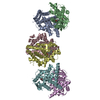
| ||||||||||||||||||||||||
|---|---|---|---|---|---|---|---|---|---|---|---|---|---|---|---|---|---|---|---|---|---|---|---|---|---|
| 1 | 
| ||||||||||||||||||||||||
| 2 | 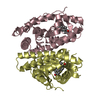
| ||||||||||||||||||||||||
| 3 | 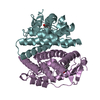
| ||||||||||||||||||||||||
| Unit cell |
| ||||||||||||||||||||||||
| Noncrystallographic symmetry (NCS) | NCS oper:
|
- Components
Components
| #1: Protein |  / ESTROGEN RECEPTOR / ER-LBD / ER-ALPHA / ESTROGEN RECEPTOR / ER-LBD / ER-ALPHAMass: 28889.021 Da / Num. of mol.: 6 / Fragment: LIGAND-BINDING DOMAIN Source method: isolated from a genetically manipulated source Details: COMPLEXED WITH ENDOGENOUS LIGAND 17 BETA-ESTRADIOL / Source: (gene. exp.)   Homo sapiens (human) / Gene: ER ALPHA / Plasmid: PEALPHA 35 / Gene (production host): ER ALPHA / Production host: Homo sapiens (human) / Gene: ER ALPHA / Plasmid: PEALPHA 35 / Gene (production host): ER ALPHA / Production host:   Escherichia coli (E. coli) / Strain (production host): JM109 / Variant (production host): C1857 / References: UniProt: P03372 Escherichia coli (E. coli) / Strain (production host): JM109 / Variant (production host): C1857 / References: UniProt: P03372#2: Chemical | ChemComp-EST /  Estradiol Estradiol#3: Water | ChemComp-HOH / |  Water Water |
|---|
-Experimental details
-Experiment
| Experiment | Method:  X-RAY DIFFRACTION / Number of used crystals: 1 X-RAY DIFFRACTION / Number of used crystals: 1 |
|---|
- Sample preparation
Sample preparation
| Crystal | Density Matthews: 2.72 Å3/Da / Density % sol: 55 % | |||||||||||||||||||||||||
|---|---|---|---|---|---|---|---|---|---|---|---|---|---|---|---|---|---|---|---|---|---|---|---|---|---|---|
Crystal grow | pH: 8.1 Details: 2.4M AMMONIUM FORMATE, 8% DIMETHYLSULPHOXIDE, 0.1M TRIS-HCL, PH 8.1 | |||||||||||||||||||||||||
| Crystal | *PLUS | |||||||||||||||||||||||||
| Crystal grow | *PLUS Temperature: 18 ℃ / Method: vapor diffusion, hanging drop | |||||||||||||||||||||||||
| Components of the solutions | *PLUS
|
-Data collection
| Diffraction | Mean temperature: 288 K |
|---|---|
| Diffraction source | Source:  SYNCHROTRON / Site: SYNCHROTRON / Site:  EMBL/DESY, HAMBURG EMBL/DESY, HAMBURG  / Beamline: X11 / Wavelength: 0.916 / Beamline: X11 / Wavelength: 0.916 |
| Detector | Type: MARRESEARCH / Detector: IMAGE PLATE / Date: May 11, 1996 |
| Radiation | Monochromatic (M) / Laue (L): M / Scattering type: x-ray |
| Radiation wavelength | Wavelength : 0.916 Å / Relative weight: 1 : 0.916 Å / Relative weight: 1 |
| Reflection | Resolution: 3.1→20 Å / Num. obs: 33981 / % possible obs: 99.1 % / Observed criterion σ(I): -3 / Redundancy: 2.5 % / Rsym value: 0.1 / Net I/σ(I): 6 |
| Reflection shell | Resolution: 3→3.15 Å / Redundancy: 2 % / Mean I/σ(I) obs: 2.5 / Rsym value: 0.448 / % possible all: 98.5 |
| Reflection | *PLUS Rmerge(I) obs: 0.1 |
- Processing
Processing
| Software |
| ||||||||||||||||||||||||||||||||||||||||||||||||||||||||||||||||||||||||||||||||||||
|---|---|---|---|---|---|---|---|---|---|---|---|---|---|---|---|---|---|---|---|---|---|---|---|---|---|---|---|---|---|---|---|---|---|---|---|---|---|---|---|---|---|---|---|---|---|---|---|---|---|---|---|---|---|---|---|---|---|---|---|---|---|---|---|---|---|---|---|---|---|---|---|---|---|---|---|---|---|---|---|---|---|---|---|---|---|
| Refinement | Method to determine structure : :  MOLECULAR REPLACEMENT / Resolution: 3.1→20 Å / Cross valid method: THROUGHOUT / σ(F): 0 / ESU R Free: 0.49 MOLECULAR REPLACEMENT / Resolution: 3.1→20 Å / Cross valid method: THROUGHOUT / σ(F): 0 / ESU R Free: 0.49 Details: BULK SOLVENT CORRECTION AND ANISOTROPIC SCALING WERE USED. PHASES FROM SIX-FOLD AVERAGING WERE INCLUDED AT ALL STAGES OF REFINEMENT. TIGHT NCS RESTRAINTS WERE MAINTAINED THROUGHOUT. ER-LBD ...Details: BULK SOLVENT CORRECTION AND ANISOTROPIC SCALING WERE USED. PHASES FROM SIX-FOLD AVERAGING WERE INCLUDED AT ALL STAGES OF REFINEMENT. TIGHT NCS RESTRAINTS WERE MAINTAINED THROUGHOUT. ER-LBD WAS CARBOXYMETHYLATED PRIOR TO CRYSTALLIZATION BUT MODIFIED CYSTEINES ARE NOT MODELLED IN THIS ENTRY.
| ||||||||||||||||||||||||||||||||||||||||||||||||||||||||||||||||||||||||||||||||||||
| Displacement parameters | Biso mean: 57.48 Å2 | ||||||||||||||||||||||||||||||||||||||||||||||||||||||||||||||||||||||||||||||||||||
| Refine analyze | Luzzati d res low obs: 5 Å / Luzzati sigma a obs: 0.38 Å | ||||||||||||||||||||||||||||||||||||||||||||||||||||||||||||||||||||||||||||||||||||
| Refinement step | Cycle: LAST / Resolution: 3.1→20 Å
| ||||||||||||||||||||||||||||||||||||||||||||||||||||||||||||||||||||||||||||||||||||
| Refine LS restraints |
| ||||||||||||||||||||||||||||||||||||||||||||||||||||||||||||||||||||||||||||||||||||
| Software | *PLUS Name: REFMAC / Classification: refinement | ||||||||||||||||||||||||||||||||||||||||||||||||||||||||||||||||||||||||||||||||||||
| Refinement | *PLUS Rfactor obs: 0.218 | ||||||||||||||||||||||||||||||||||||||||||||||||||||||||||||||||||||||||||||||||||||
| Solvent computation | *PLUS | ||||||||||||||||||||||||||||||||||||||||||||||||||||||||||||||||||||||||||||||||||||
| Displacement parameters | *PLUS |
 Movie
Movie Controller
Controller



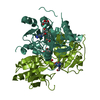
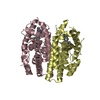
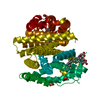

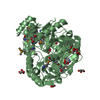


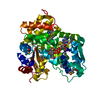
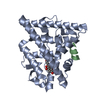
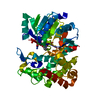
 PDBj
PDBj





